Sally Murphy's Blog, page 2
March 31, 2025
What I Read in March 2025
Another new month, another look back at what I read last month. as you’ll see, I took another dive into the works of a favourite picture book creator, amongst other fabulous reads, with a total of nine books for the month.
Books for Younger Readers Into the Blue, by Cristy Burne (Fremantle Press, 2024). I love reading books about places I know well, so a story which, in part, takes place on one of my favourite snorkelling spots, the Omeo Wreck in Coogee, WA, is a real treat. But, while snorkelling is certainly part of the story, it is also about family, honesty and doing the right thing, packaged in a very readable tale.
Into the Blue, by Cristy Burne (Fremantle Press, 2024). I love reading books about places I know well, so a story which, in part, takes place on one of my favourite snorkelling spots, the Omeo Wreck in Coogee, WA, is a real treat. But, while snorkelling is certainly part of the story, it is also about family, honesty and doing the right thing, packaged in a very readable tale.
 Kelpie Chaos, by Deb Fitzpatrick (Fremantle Press, 2024). What’s not love about another book set in WA, and featuring a puppy? This one features a loveable kelpie called Zoom, who lives up to his name and causes a few problems along the way.
Kelpie Chaos, by Deb Fitzpatrick (Fremantle Press, 2024). What’s not love about another book set in WA, and featuring a puppy? This one features a loveable kelpie called Zoom, who lives up to his name and causes a few problems along the way.
 I Like Books, by Anthony Browne (Walker Books, 2003). I love the work of Anthony Browne, and a social media post from a friend and colleague sent me on a bit of a buying and reading spree, to fill some gaps in my collection. This is the first of several, and the title says it all.
I Like Books, by Anthony Browne (Walker Books, 2003). I love the work of Anthony Browne, and a social media post from a friend and colleague sent me on a bit of a buying and reading spree, to fill some gaps in my collection. This is the first of several, and the title says it all.
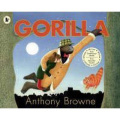 Gorilla, by Anthony Browne (Walker Books, 1983). Another of Browne’s work, the story of a lonely girl and a gorilla.
Gorilla, by Anthony Browne (Walker Books, 1983). Another of Browne’s work, the story of a lonely girl and a gorilla.
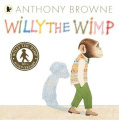 Willy the Wimp And another. The first Browne book I ever saw was a Willy book, so always lovely to continue to meet him in others.
Willy the Wimp And another. The first Browne book I ever saw was a Willy book, so always lovely to continue to meet him in others.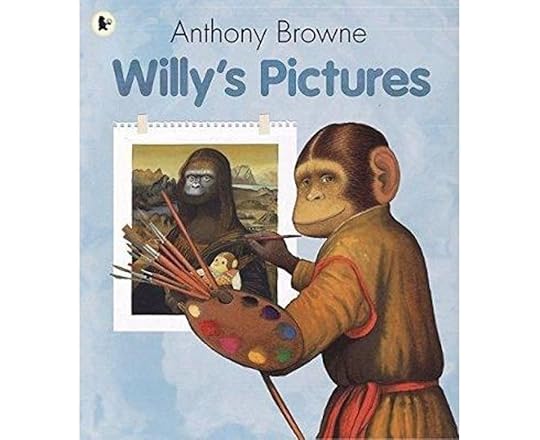 Willy’s Pictures, by Anthony Browne. And a third. This one is really clever. Willy paints pictures which look very familiar – they are like famous paintings from da Vinci, Manet and more – but with Willy and his friends replacing human figures.
Willy’s Pictures, by Anthony Browne. And a third. This one is really clever. Willy paints pictures which look very familiar – they are like famous paintings from da Vinci, Manet and more – but with Willy and his friends replacing human figures.
 Dragon Skin, by Karen Foxlee (Allen & Unwin, 2021). Not sure why I hadn’t read this before. It is stunningly moving, heart wrenching, and easy to see why it was an Honour Book in the 2022 CBCA Book of the Year Awards.Books for Adults
Dragon Skin, by Karen Foxlee (Allen & Unwin, 2021). Not sure why I hadn’t read this before. It is stunningly moving, heart wrenching, and easy to see why it was an Honour Book in the 2022 CBCA Book of the Year Awards.Books for Adults
 What Happened to Nina?, by Dervla McTiernan (Harper Collins, 2024). I ended last month with a couple of murder mysteries, and began the month with this one, not exactly a mystery, but certainly a thriller, with layers of complexity around relationships, families and the lengths they will go to.
What Happened to Nina?, by Dervla McTiernan (Harper Collins, 2024). I ended last month with a couple of murder mysteries, and began the month with this one, not exactly a mystery, but certainly a thriller, with layers of complexity around relationships, families and the lengths they will go to.
 Virginia Lane is Not a Hero, by Rosalind Stopps (Harper Collins, 2024). While the front cover perhaps suggests a lighter feel, this is a read which deals with some weighty topics – grief, child abuse, terminal illness, suicide, race and more. But, at the same time, it offers hope and show what ordinary people can achieve when they come together to solve big problems.
Virginia Lane is Not a Hero, by Rosalind Stopps (Harper Collins, 2024). While the front cover perhaps suggests a lighter feel, this is a read which deals with some weighty topics – grief, child abuse, terminal illness, suicide, race and more. But, at the same time, it offers hope and show what ordinary people can achieve when they come together to solve big problems.That brings my total for the year so far to 28. Definitely fewer books that I used to get through when I wasn’t a full time academic, which in some ways is a shame, but does mean that I really treasure any time to read for pleasure. I’d love to hear what you’ve been reading lately.
March 19, 2025
Reading to you on World Read Aloud Day
It’s World Read Aloud Day and, what better way for me to celebrate than by reading aloud to you. Enjoy!
View this post on Instagram
A post shared by Sally Murphy (@sallymurphyauthor)
February 28, 2025
Happy Birthday, Teenager
 Birthdays are always special, but when a book has a birthday and is still in print, that feels extra special for an author. Especially when that book has stayed in print for more than a few years.
Birthdays are always special, but when a book has a birthday and is still in print, that feels extra special for an author. Especially when that book has stayed in print for more than a few years.
So, happy happy birthday to Do Not Forget Australia which is 13 years old today – a teenager! That’s right, it’s been in print for 13 whole years, and is still available.
Telling the story of the school in the French village of Villers-Bretonneux which is famous for having signs saying boldly Do Not Forget Australia, and of the events which led to that happening, Do Not Forget Australia is a wars story but also a story of friendship.
Perfect for classroom use, including in the lead up to ANZAC Day, I hope it continues to be shared for many more years to come. 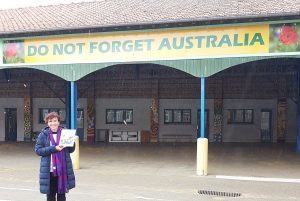
February 27, 2025
What I Read in February 2025
Last day of February means time to share what I read this month. As always a mixed bag, including classic picture books, murder mysteries, poetry and more. I especially enjoyed spending so much time with illustrator Ron Brooks. What a treat! Here’s what I read:
Books for Young Readers The Day No One was Angry, by Toon Tellegen & Marc Boutavant (Gecko Press, 2014). Such a delight to read, this set of stories with a philosophical bent is of whimsical and thought provoking in equal measure.
The Day No One was Angry, by Toon Tellegen & Marc Boutavant (Gecko Press, 2014). Such a delight to read, this set of stories with a philosophical bent is of whimsical and thought provoking in equal measure.
 The Biggest Christmas Secret Ever!, by L. D. Lapinski (Orion, 2024). This was a Christmas treat from my gorgeous colleague (and friend) Tamara – but, because of my own busyness in December I only collected it this month. But a Christmas book in February is, in my mind, perfectly acceptable, and I enjoyed this.Land of the Rainbow Gold, edited by Mildred M. Fowler (Nelson, 1967). Not sure whether to put this one in the young readers category because, while it was initially published for primary school aged readers, its age, and some of the sentiments expressed, including in the introduction, mean it isn’t a book I would give a child without some critical interrogation involved.
The Biggest Christmas Secret Ever!, by L. D. Lapinski (Orion, 2024). This was a Christmas treat from my gorgeous colleague (and friend) Tamara – but, because of my own busyness in December I only collected it this month. But a Christmas book in February is, in my mind, perfectly acceptable, and I enjoyed this.Land of the Rainbow Gold, edited by Mildred M. Fowler (Nelson, 1967). Not sure whether to put this one in the young readers category because, while it was initially published for primary school aged readers, its age, and some of the sentiments expressed, including in the introduction, mean it isn’t a book I would give a child without some critical interrogation involved.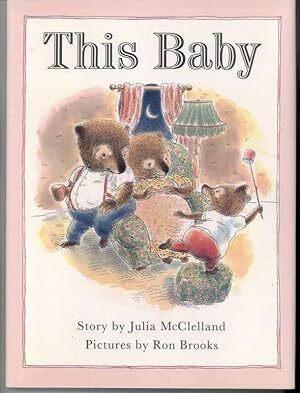 This Baby ,by Julia Mclelland & Ron Brooks (Oxford, 1992). Having read Ron Brooks’ memoir (see below) I found myself chasing down some of his backlist which I just HAD to own. This one is just beautiful – and, as a bonus, I got a signed copy.
This Baby ,by Julia Mclelland & Ron Brooks (Oxford, 1992). Having read Ron Brooks’ memoir (see below) I found myself chasing down some of his backlist which I just HAD to own. This one is just beautiful – and, as a bonus, I got a signed copy. Timothy and Gramps, by Ron Brooks (Collins, 1978). And another Ron Brooks title, which I knew of but had not read. Beautiful.
Timothy and Gramps, by Ron Brooks (Collins, 1978). And another Ron Brooks title, which I knew of but had not read. Beautiful.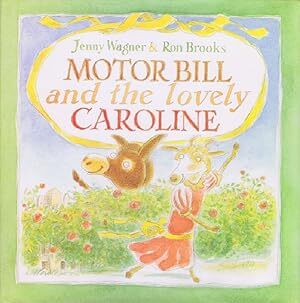 Motor Bill and the Lovely Caroline, by Jenny Wagner & Ron Brooks (Viking, 1994) And a third book illustrated by Brooks. If I had to pick a favourite of these three, this one would be it.
Motor Bill and the Lovely Caroline, by Jenny Wagner & Ron Brooks (Viking, 1994) And a third book illustrated by Brooks. If I had to pick a favourite of these three, this one would be it.
 Laughter is the Best Ending, by Maryam Master, illustrated by Astred Hicks (Pan, 2024). Just listed on the Notables list for the CBCA Book of the Year Awards, and I can see why. Dealing with death, friendship, difference and belonging, while also being fast paced and funny, isn’t an easy mix, by Master does it well here.Books for Young Adult Readers
Laughter is the Best Ending, by Maryam Master, illustrated by Astred Hicks (Pan, 2024). Just listed on the Notables list for the CBCA Book of the Year Awards, and I can see why. Dealing with death, friendship, difference and belonging, while also being fast paced and funny, isn’t an easy mix, by Master does it well here.Books for Young Adult Readers
 Game As Ned, by Tim Pegler, Angus & Robertson, 2008) I read and reviewed this book back in 2008, but found it on my shelf and couldn’t remember it until I was well into it. That’s not a reflection of the quality – just of the number of books I read, and have read since 2008. Well worth the reread and, if you’re interested in that review it’s here.
Game As Ned, by Tim Pegler, Angus & Robertson, 2008) I read and reviewed this book back in 2008, but found it on my shelf and couldn’t remember it until I was well into it. That’s not a reflection of the quality – just of the number of books I read, and have read since 2008. Well worth the reread and, if you’re interested in that review it’s here.Books for Adult Readers
 Everyone In My Family Has Killed Someone, by Benjamin Stevenson (Penguin, 2022. Late to the party reading this one, which I’ve seen everywhere over the past few years, but hadn’t read. I listened to it in audio format, and found the voice excellent, as well as the mystery with a twist of comedy.
Everyone In My Family Has Killed Someone, by Benjamin Stevenson (Penguin, 2022. Late to the party reading this one, which I’ve seen everywhere over the past few years, but hadn’t read. I listened to it in audio format, and found the voice excellent, as well as the mystery with a twist of comedy.
 Drawn from the Heart: A Memoir, by Ron Brooks (Allen & Unwin, 2010). Another book which I’d read and reviewed many moons ago but which kept calling me for a reread. Well worth the time and the tears, and the money spent ordering some Brooks’ backlist. You can see my original review here.
Drawn from the Heart: A Memoir, by Ron Brooks (Allen & Unwin, 2010). Another book which I’d read and reviewed many moons ago but which kept calling me for a reread. Well worth the time and the tears, and the money spent ordering some Brooks’ backlist. You can see my original review here.
 Kill Your Husbands, by Jack Heath (Allen & Unwin, 2023). Another that I listened to on audio, and enjoyed. I managed to figure out whodunnit but there were still twists and turns and character insights aplenty.
Kill Your Husbands, by Jack Heath (Allen & Unwin, 2023). Another that I listened to on audio, and enjoyed. I managed to figure out whodunnit but there were still twists and turns and character insights aplenty.That brings my total for the year to date to 19 books. Not a bad start to the year. I’d love to hear what you’ve been reading.
February 26, 2025
A Right Way Up Birthday Celebration
Happy birthday to you
Happy birthday Right Way Dooooowwwn
Happy birthday to yooooouuuuuu.
Yes, it’s true, it’s been one whole year today since Right Way Down made its way out into the world. And what a year it has been. From launch events, to bookshop shelves, to schools, to homes and hearts across Australia, this little book has spread joy everywhere it has gone. And will continue to do so for years to come.
Right Way Down is not the first book with my name on the cover, but it is one of the most joyful publishing experiences I’ve ever had – because I got to edit it with my talented and wonderful friend Rebecca M. Newman, and watch as Briony Stewart brought the book to life with divine illustrations, and then Fremantle Press published it and got it out there. Not only that, but, as an anthology, a major part of the joy was seeing so many other poets – friends old and new – see their work included.
And of course, another special joy is knowing that young readers are getting to read the poems – after all, that is why we produced this book.
So, while I can’t hand out pieces of birthday cake here on my website, wherever you are, please accept a piece of virtual cake in the form of a massive
THANK YOUfor loving the book as much as we do.
If you’ve not yet read Right Way Down don’t be sad – it is still available in good bookstores and online and, in 2026, there will be a second anthology, so watch this space.
January 31, 2025
What I Read in January 2025
How is the first month of 2025 over already? Yesterday was Christmas and today is February? Anyway, in spite of the month racing by, I did manage to get 8 books finished, and here’s what they were:
Books for Children
The Rocks of Honey, by Patricia Wrightson (Puffin Books, 1960). Starting the year as I ended the last, with something from my seemingly endless to-read cupboard, and filling some gaps in my reading of Australian children’s classics at the same time. Wrightson was ground breaking in her work, and this one, drawing on first nations mythology, is no exception. And, of course, in the modern context in which I read it, I had to filter my concerns about appropriation as I read, remembering that Wrightson wrote in a different time and with good intent. I found this blogpost by Academic Mark Macleod helpful in giving me context.Sugar Mouse, by John Branfield (Gollancz,1973).Another from the to-read cupboard, this one was rescued from a library cull some time ago. It’s a bit dated in some of its depictions of women and girls, but is unusual in that it offers an insight in to the life a girl living with diabetes. Again, the treatments and management are a bit dated, but an important topic. The Peppermint Pig, by Nina Bawden (Puffin Books, 1975). Third book in a row from the t0-read cupboard. I’m not sure where I came upon this. It was a 1975 edition, but seemed unread. Anyway, I read it and enjoyed the story of a family facing difficult times, and the role of a piglet in helping them through it.
The Peppermint Pig, by Nina Bawden (Puffin Books, 1975). Third book in a row from the t0-read cupboard. I’m not sure where I came upon this. It was a 1975 edition, but seemed unread. Anyway, I read it and enjoyed the story of a family facing difficult times, and the role of a piglet in helping them through it.
 Millie Mak the Maker , by Alice Pung & Sher Rill Ng (Angus & Roberston, 2023). I’ve admired this book in bookshops several times, and finally bought it and read ti this month. The gorgeous hard cover is just part of its joy. Inside there are two stories featuring Millie Mak, who sews and makes things by repurposing discarded things, at the same time navigating challenges with friendship and family. Just lovely.
Millie Mak the Maker , by Alice Pung & Sher Rill Ng (Angus & Roberston, 2023). I’ve admired this book in bookshops several times, and finally bought it and read ti this month. The gorgeous hard cover is just part of its joy. Inside there are two stories featuring Millie Mak, who sews and makes things by repurposing discarded things, at the same time navigating challenges with friendship and family. Just lovely.
 Detective Gordon: A Complicated Case, by Ulf Nilsson, illustrated by Gitte Spee (Gecko Press, 2016). Back to the to-read cupboard which, at this rate, could be emptied by about 2030 (there are a lot of books there). I suspect his one was an unsolicited review copy which means I’ve had it for nine years, unread. It is a really cute little book, using animal characters to look at what it takes not to be mean. Very clever.
Detective Gordon: A Complicated Case, by Ulf Nilsson, illustrated by Gitte Spee (Gecko Press, 2016). Back to the to-read cupboard which, at this rate, could be emptied by about 2030 (there are a lot of books there). I suspect his one was an unsolicited review copy which means I’ve had it for nine years, unread. It is a really cute little book, using animal characters to look at what it takes not to be mean. Very clever.
 Look Me in the Eye, by Jane Godwin Lothian, 2024). Jane Godwin is adept at writing for the tween age group. Bella is navigating the first year of high school, but along with the usual challenges this might bring, she’s also dealing with issues of peer pressure and trust.
Look Me in the Eye, by Jane Godwin Lothian, 2024). Jane Godwin is adept at writing for the tween age group. Bella is navigating the first year of high school, but along with the usual challenges this might bring, she’s also dealing with issues of peer pressure and trust.
Books for Adults
 The Elephant Vanishes, by Haruki Murakami (Vintage, 1994). I was gifted this by a friend who wanted me to read it so he had someone to talk to about it. I love that! And I also loved this book, which is my much-belated introduction to Murakami’s work.
The Elephant Vanishes, by Haruki Murakami (Vintage, 1994). I was gifted this by a friend who wanted me to read it so he had someone to talk to about it. I love that! And I also loved this book, which is my much-belated introduction to Murakami’s work.
 Swimming to Antarctica: Tales of a Long-Distance Swimmer, by Lynne Cox (Harcourt, 2004). Lent to me by a member of my swimming book, and I really enjoyed getting inside the mindset, and life, of this legendary swimmer who didn’t stop once she’d set the record for the English Channel crossing at age sixteen, instead swimming her way into the record books around the world – including swimming in Antarctic waters.
Swimming to Antarctica: Tales of a Long-Distance Swimmer, by Lynne Cox (Harcourt, 2004). Lent to me by a member of my swimming book, and I really enjoyed getting inside the mindset, and life, of this legendary swimmer who didn’t stop once she’d set the record for the English Channel crossing at age sixteen, instead swimming her way into the record books around the world – including swimming in Antarctic waters.And of course, that brings my total for the year so far to 8. I’d love to hear what you’ve been reading.
January 17, 2025
Books to Use in Your Secondary Classroom in 2025
This week I have been sharing book suggestions for classrooms from Early Childhood to upper primary. To finish this series, today I’m highlighting some of my books which could be used in the secondary classroom. Although not marketed as young adult, these are titles which I know have been used in secondary classrooms or which appear on reading lists for secondary aged students.
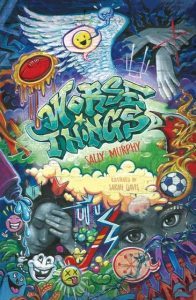 Worse Things (illustrated by Sarah Davis, published by Walker Books) is a multi-voice verse novel about sport, belonging and unexpected things. It was an Honour Book in the 2021 CBCA Book of the Year Awards, which I’m pretty proud of, but I’m even more proud that young readers seem to really engage with it, both for inclass study and individual reading. There are a plethora of resources for teaching Worse Things, including publisher teacher notes here, and a unit of work from PETAA here. The NSW Department of Education has a comprehensive unit of work available here. Although these resources are chiefly aimed at primary classrooms, they can be adapted for secondary students. I have used the Definition poems from the book for the basis of poetry writing workshops with high school aged students really successfully.You also might find this video introduction featuring yours truly helpful.
Worse Things (illustrated by Sarah Davis, published by Walker Books) is a multi-voice verse novel about sport, belonging and unexpected things. It was an Honour Book in the 2021 CBCA Book of the Year Awards, which I’m pretty proud of, but I’m even more proud that young readers seem to really engage with it, both for inclass study and individual reading. There are a plethora of resources for teaching Worse Things, including publisher teacher notes here, and a unit of work from PETAA here. The NSW Department of Education has a comprehensive unit of work available here. Although these resources are chiefly aimed at primary classrooms, they can be adapted for secondary students. I have used the Definition poems from the book for the basis of poetry writing workshops with high school aged students really successfully.You also might find this video introduction featuring yours truly helpful.Worse Things is still in print and available in print and ebook versions in bookstores or online and appears on four Premier’s Reading Challenge booklists – in WA, Queensland, South Australia, and Victoria.
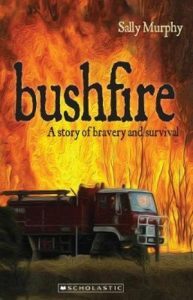 Bushfire (Published by Scholastic). Part of the My Australian Story series, this tells the story of the dreadful 2009 bushfires which ravaged Victoria, from the viewpoint of a fictional girl called Amy, who experiences the fires first hand. It obviously deals with natural disasters, but also focusses on notions of bravery, family and the topic of climate change.How it can be used: Bushfire is useful for studies of narrative, as well as HASS and Science themes. You can find publisher teaching notes here . Another truly excellent resource is the Black Saturday Museum in Marysville (where much of the book is set) and its website. This song (and its video) by Greg Campion) provides an audio-visual link which can be very powerful.https://www.blacksaturdaymuseum.com/video/This_Is_My_Town-BSMa.mp4
Bushfire (Published by Scholastic). Part of the My Australian Story series, this tells the story of the dreadful 2009 bushfires which ravaged Victoria, from the viewpoint of a fictional girl called Amy, who experiences the fires first hand. It obviously deals with natural disasters, but also focusses on notions of bravery, family and the topic of climate change.How it can be used: Bushfire is useful for studies of narrative, as well as HASS and Science themes. You can find publisher teaching notes here . Another truly excellent resource is the Black Saturday Museum in Marysville (where much of the book is set) and its website. This song (and its video) by Greg Campion) provides an audio-visual link which can be very powerful.https://www.blacksaturdaymuseum.com/video/This_Is_My_Town-BSMa.mp4Bushfire is still available from good bookstores and online and appears on the reading lists for the Victorian, and SA Premier’s Reading Challenge.
 The Riding Gallery (illustrated by Martina Heiduczek, published by Walker Books). My most recent book, this is the story of the home front during WW1, focussing on the events surrounding a real merry go round (riding gallery) on the St Kilda foreshore. Told using free verse from the viewpoints of two children, the merry go round operator, and the newspapers of the times.What it Can Be Used For: There are HASS and history tie-ins, but, being a verse novel, this one can also be used to teach poetic forms (including found poems), figurative language and more. If you are in the ACT, you might link the story to the merry go round located in the Civic centre – as this is the very ride which features in the book – and, if in Victoria, the book again has strong links to local history, taking place in St Kilda. You can find teacher notes at the Walker site here and PETAA has an excellent unit of work aimed at the year 3 classroom (which could be adapted for older students) and linking not just to HASS but also to HPE. You can find that here . The Riding Gallery is available in good bookstores in both print and ebook formats, as well as in libraries.
The Riding Gallery (illustrated by Martina Heiduczek, published by Walker Books). My most recent book, this is the story of the home front during WW1, focussing on the events surrounding a real merry go round (riding gallery) on the St Kilda foreshore. Told using free verse from the viewpoints of two children, the merry go round operator, and the newspapers of the times.What it Can Be Used For: There are HASS and history tie-ins, but, being a verse novel, this one can also be used to teach poetic forms (including found poems), figurative language and more. If you are in the ACT, you might link the story to the merry go round located in the Civic centre – as this is the very ride which features in the book – and, if in Victoria, the book again has strong links to local history, taking place in St Kilda. You can find teacher notes at the Walker site here and PETAA has an excellent unit of work aimed at the year 3 classroom (which could be adapted for older students) and linking not just to HASS but also to HPE. You can find that here . The Riding Gallery is available in good bookstores in both print and ebook formats, as well as in libraries.
It seems I talk with my hands a lot. Who knew?
I’m also a qualified and experienced secondary English teacher, meaning I love to visit and work with highschool students and teachers to talk about reading, writing, poetry and more. Feel free to contact me to find out more. You can also do the same if you’d like some advice on using my books in your classroom.
If you’ve followed this series of posts you’ll see that I have written books that cover an array of subjects, formats and audiences. Hopefully you’ll find something here to suit your classroom but, if your don’t please feel free to drop me a line and ask me questions. Or, of course, remember there are many other wonderful Australian creators writing wonderful books that might suit your needs.
Whatever books you use, and whatever age group you are teaching, thank you for the work you are doing educating our next generation. Teachers rock!
January 16, 2025
Books to Use in Your Upper Primary Classroom in 2025
This is the fourth post in this series – each one focussing on a different level of schooling. the idea is that, if you are a teacher preparing for the 2025 school year, you might find some ideas for using one or more of my books in your English or other lessons. Today I’m focussing upper primary, so if you are teaching Year 5 or Year 6, this post is for you.
Turns out that upper primary is really the sweet spot for a lot of my books, so this post will be longish.
First up, novels, including verse novels.
 Bushfire (Published by Scholastic). Part of the My Australian Story series, this tells the story of the dreadful 2009 bushfires which ravaged Victoria, from the viewpoint of a fictional girl called Amy, who experiences the fires first hand. It obviously deals with natural disasters, but also focusses on notions of bravery, family and the topic of climate change.How it can be used: Bushfire is useful for studies of narrative, as well as HASS and Science themes. I have heard of several school using it a unit of work on natural disasters, including Clyde Primary in Victoria, who you can read about here. You can find publisher teaching notes here, and a great complementary title The Bushfire Book by Polly Marsden also has excellent teaching notes, which you can find here. Another truly excellent resource is the Black Saturday Museum in Marysville (where much of the book is set) and its website. This song (and its video) by Greg Campion) provides an audio-visual link which can be very powerful.https://www.blacksaturdaymuseum.com/video/This_Is_My_Town-BSMa.mp4
Bushfire (Published by Scholastic). Part of the My Australian Story series, this tells the story of the dreadful 2009 bushfires which ravaged Victoria, from the viewpoint of a fictional girl called Amy, who experiences the fires first hand. It obviously deals with natural disasters, but also focusses on notions of bravery, family and the topic of climate change.How it can be used: Bushfire is useful for studies of narrative, as well as HASS and Science themes. I have heard of several school using it a unit of work on natural disasters, including Clyde Primary in Victoria, who you can read about here. You can find publisher teaching notes here, and a great complementary title The Bushfire Book by Polly Marsden also has excellent teaching notes, which you can find here. Another truly excellent resource is the Black Saturday Museum in Marysville (where much of the book is set) and its website. This song (and its video) by Greg Campion) provides an audio-visual link which can be very powerful.https://www.blacksaturdaymuseum.com/video/This_Is_My_Town-BSMa.mp4Bushfire is still available from good bookstores and online and appears on the reading lists for the Victorian, NSW and SA Premier’s Reading Challenge.
 Worse Things (illustrated by Sarah Davis, published by Walker Books) is a multi-voice verse novel about sport, belonging and unexpected things. It was an Honour Book in the 2021 CBCA Book of the Year Awards, which I’m pretty proud of, but I’m even more proud that young readers seem to really engage with it, both for inclass study and individual reading. There are a plethora of resources for teaching Worse Things, including publisher teacher notes here, and a unit of work from PETAA here. The NSW Department of Education has a comprehensive unit of work available here. You might find this video introduction featuring yours truly helpful.
Worse Things (illustrated by Sarah Davis, published by Walker Books) is a multi-voice verse novel about sport, belonging and unexpected things. It was an Honour Book in the 2021 CBCA Book of the Year Awards, which I’m pretty proud of, but I’m even more proud that young readers seem to really engage with it, both for inclass study and individual reading. There are a plethora of resources for teaching Worse Things, including publisher teacher notes here, and a unit of work from PETAA here. The NSW Department of Education has a comprehensive unit of work available here. You might find this video introduction featuring yours truly helpful..
Worse Things is still in print and available in print and ebook versions in bookstores or online and appears on five Premier’s Reading Challenge booklists – in WA, Queensland, South Australia, Victoria and NSW.
 The Riding Gallery (illustrated by Martina Heiduczek, published by Walker Books). My most recent book, this is the story of the homefront during WW1, focussing on the events surrounding a real merry go round (riding gallery) on the St Kilda foreshore. Told using free verse from the viewpoints of two children, the merry go round operator, and the newspapers of the times.What it Can Be Used For: As mentioned, there are HASS and history tie-ins, but, being a verse novel, this one can also be used to teach poetic forms (including found poems), figurative language and more. If you are in the ACT, you might link the story to the merry go round located in the Civic centre – as this is the very ride which features in the book – and, if in Victoria, the book again has strong links to local history, taking place in St Kilda. You can find teacher notes at the Walker site here and PETAA has an excellent unit of work aimed at the year 3 (which could be adapted for upper primary) classroom and linking not just to HASS but also to HPE. You can find that here . The Riding Gallery is available in good bookstores in both print and ebook formats, as well as in libraries and appears on the SA Premiers’ Reading Challenge booklist.
The Riding Gallery (illustrated by Martina Heiduczek, published by Walker Books). My most recent book, this is the story of the homefront during WW1, focussing on the events surrounding a real merry go round (riding gallery) on the St Kilda foreshore. Told using free verse from the viewpoints of two children, the merry go round operator, and the newspapers of the times.What it Can Be Used For: As mentioned, there are HASS and history tie-ins, but, being a verse novel, this one can also be used to teach poetic forms (including found poems), figurative language and more. If you are in the ACT, you might link the story to the merry go round located in the Civic centre – as this is the very ride which features in the book – and, if in Victoria, the book again has strong links to local history, taking place in St Kilda. You can find teacher notes at the Walker site here and PETAA has an excellent unit of work aimed at the year 3 (which could be adapted for upper primary) classroom and linking not just to HASS but also to HPE. You can find that here . The Riding Gallery is available in good bookstores in both print and ebook formats, as well as in libraries and appears on the SA Premiers’ Reading Challenge booklist.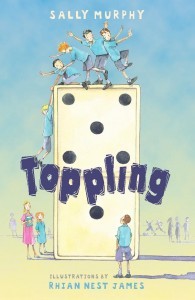 Toppling (illustrated by Rian Nest James, published by Walker Books). A story of friendship, it also delas with childhood cancer, giving it applicability in the HPE classroom as well as a class read aloud. Teacher’s notes for Toppling are available on the Walker Books website and further suggestion, aimed specifically at Year 6, are here.Toppling is still in print and available in good bookstores or online and appears on the booklist for the Premier’s Reading Challenge in WA, NSW, Victoria and SA.
Toppling (illustrated by Rian Nest James, published by Walker Books). A story of friendship, it also delas with childhood cancer, giving it applicability in the HPE classroom as well as a class read aloud. Teacher’s notes for Toppling are available on the Walker Books website and further suggestion, aimed specifically at Year 6, are here.Toppling is still in print and available in good bookstores or online and appears on the booklist for the Premier’s Reading Challenge in WA, NSW, Victoria and SA. Pearl Verses the World (illustrated by heather Potter, published by Walker Books) is a story of belonging, of family and also of grief. Told using the verse novel format it again has links to HPE as well as making an excellent class read aloud.What it Can Be Used For. Because it uses free verse poetry (as well as some shorter rhyming poems), there is lots of opportunity to address poetic and language devices. among many other uses. The wonderful Kirwan Primary School in Queensland has used Pearl and some of my other verse novels for a year six unit of work for many years,, including studying author’s style, poetry and more. Teacher’s notes for Pearl Verses the World are available on the Walker Books website, and my ideas for using the book in a year five classroom are available here.
Pearl Verses the World (illustrated by heather Potter, published by Walker Books) is a story of belonging, of family and also of grief. Told using the verse novel format it again has links to HPE as well as making an excellent class read aloud.What it Can Be Used For. Because it uses free verse poetry (as well as some shorter rhyming poems), there is lots of opportunity to address poetic and language devices. among many other uses. The wonderful Kirwan Primary School in Queensland has used Pearl and some of my other verse novels for a year six unit of work for many years,, including studying author’s style, poetry and more. Teacher’s notes for Pearl Verses the World are available on the Walker Books website, and my ideas for using the book in a year five classroom are available here.Speaking of poetry, I love writing and teaching poetry, and these two books are ideal for upper primary:
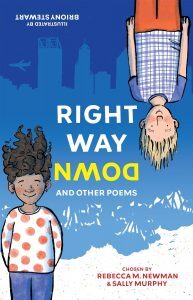 Right Way Down (edited by Rebecca M. Newman and myself and published by Fremantle Press) is aimed chiefly at middle and upper primary students and is suitable both for in class use and private reading, with poems in a wide range of of forms, and on a variety of topics, all written by contemporary poets. You will find teaching notes here and printable poetry activities here. Right Way Down is still available in good stores or online in hard copy or ebook format.
Right Way Down (edited by Rebecca M. Newman and myself and published by Fremantle Press) is aimed chiefly at middle and upper primary students and is suitable both for in class use and private reading, with poems in a wide range of of forms, and on a variety of topics, all written by contemporary poets. You will find teaching notes here and printable poetry activities here. Right Way Down is still available in good stores or online in hard copy or ebook format. Teaching Poetry for Pleasure and Purpose ( Published by PETAA) is, as the title suggests, designed to help you in teaching poetry in pleasurable ways, but also with the purpose of supporting the demands of the curriculum. There is a chapter for each primary school year, including Years 5 and 6, unpacking key terminology, suggesting activities both in reading and writing, and including poems and suggestions for further resources. Teaching Poetry for Pleasure and Purpose is available directly from PETAA in both hardcopy and digital formats. PETAA also offer an online professional learning module of the same name, where you can hear more from me on the teaching of poetry.
Teaching Poetry for Pleasure and Purpose ( Published by PETAA) is, as the title suggests, designed to help you in teaching poetry in pleasurable ways, but also with the purpose of supporting the demands of the curriculum. There is a chapter for each primary school year, including Years 5 and 6, unpacking key terminology, suggesting activities both in reading and writing, and including poems and suggestions for further resources. Teaching Poetry for Pleasure and Purpose is available directly from PETAA in both hardcopy and digital formats. PETAA also offer an online professional learning module of the same name, where you can hear more from me on the teaching of poetry.This is just a portion of what I have written suitable for this age group. There are also several reading series titles and novels including Looking Up and Doggy Duo as well as my historical picture books Do Not Forget Australia and Meet Mary Mackillop, featured in earlier posts in this series.
 And, if you’d like to see me in person, I am available to visit your school for author visits or to run professional learning. Feel free to contact me to find out more. You can also do the same if you’d like some advice on using my books in your classroom.
And, if you’d like to see me in person, I am available to visit your school for author visits or to run professional learning. Feel free to contact me to find out more. You can also do the same if you’d like some advice on using my books in your classroom.
January 15, 2025
Books to Include in Your Middle Primary Classroom in 2025
So far in this series of posts, I’ve offered suggestions for books for Early Childhood and Junior Primary classrooms. Today, if you are a teacher of Middle Primary – years 3 and 4 – this post is for you. The goal is to highlight books I’ve written which you can use in your classroom, linking up with resources which can support you. I hope you find it useful.
Firstly, if you are looking for fiction to help you explore history, notable Australians or to link to the subject of HASS, then I have the following titles suitable for this age group.
 The Riding Gallery (illustrated by Martina Heiduczek, published by Walker Books). My most recent book, this is the story of the homefront during WW1, focussing on the events surrounding a real merry go round (riding gallery) on the St Kilda foreshore. Told using free verse from the viewpoints of two children, the merry go round operator, and the newspapers of the times.
The Riding Gallery (illustrated by Martina Heiduczek, published by Walker Books). My most recent book, this is the story of the homefront during WW1, focussing on the events surrounding a real merry go round (riding gallery) on the St Kilda foreshore. Told using free verse from the viewpoints of two children, the merry go round operator, and the newspapers of the times. What it Can Be Used For: As mentioned, there are HASS and history tie-ins, but, being a verse novel, this one can also be used to teach poetic forms (including found poems), figurative language and more. If you are in the ACT, you might link the story to the merry go round located in the Civic centre – as this is the very ride which features in the book – and, if in Victoria, the book again has strong links to local history, taking place in St Kilda.
You can find teacher notes at the Walker site here and PETAA has an excellent unit of work aimed at the year 3 classroom and linking not just to HASS but also to HPE. You can find that here . You can see and hear the organ from The Riding Gallery , as well as glimpses of the ride, still operating in Canberra, in this video.
The book is available in good bookstores in both print and ebook formats, as well as in libraries and could be used alongside the next book, also set in WW2 and also with links to Victoria.
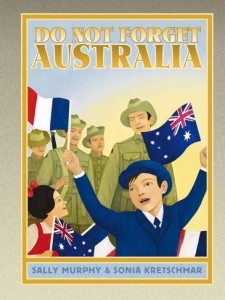 Do Not Forget Australia (illustrated by Sonia Kretschmar and published by Walker Books). Telling a story of friendship between two boys and between two countries, through the events at the French village of Villers-Bretonneux in and after World War 1.
Do Not Forget Australia (illustrated by Sonia Kretschmar and published by Walker Books). Telling a story of friendship between two boys and between two countries, through the events at the French village of Villers-Bretonneux in and after World War 1.What it Can Be Used For: Because the battle of Villers-Bretonneux happened on ANZAC Day, this is an excellent resource leading up to ANZAC Day, but also Remembrance Day.).Do Not Forget Australia is included on the Victorian Premier’s Reading Challenge booklist. You will find publisher teaching notes here and some suggestions for using the book in the Year Five classroom, here. Although aimed at junior primary these suggestions may also be helpful.
Do Not Forget Australia is still in print, and available in good bookstores or online.
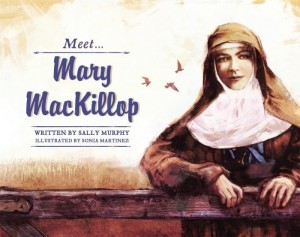 Meet Mary Mackillop (illustrated by Sonia Martinez, published by Random House). Part of the fabulous ‘Meet…’ series from random House, this is a fictionalised story of the life of Mary Mackillop, with a back of book timeline of her life.What it Can Be Used For: Because it features a famous Australian, there are obvious HASS uses, as well as use in Catholic schools, with Mary Mackillop being Australia’s first saint. But this is also the story of a strong woman, and highlights social justice and history, so is suitable for all classrooms. You will find publisher teacher notes here and suggestions for the year 4 classroom here. Meet Mary MacKillop appears on the booklist for the Victorian Premier’s Reading Challenge and is still available in good bookstores or online.
Meet Mary Mackillop (illustrated by Sonia Martinez, published by Random House). Part of the fabulous ‘Meet…’ series from random House, this is a fictionalised story of the life of Mary Mackillop, with a back of book timeline of her life.What it Can Be Used For: Because it features a famous Australian, there are obvious HASS uses, as well as use in Catholic schools, with Mary Mackillop being Australia’s first saint. But this is also the story of a strong woman, and highlights social justice and history, so is suitable for all classrooms. You will find publisher teacher notes here and suggestions for the year 4 classroom here. Meet Mary MacKillop appears on the booklist for the Victorian Premier’s Reading Challenge and is still available in good bookstores or online.Secondly, as well as The Riding Gallery, I have four other verse novels suitable for middle primary.
 Pearl Verses the World (illustrated by heather Potter, published by Walker Books) is a story of belonging, of family and also of grief. Told using the verse novel format it again has links to HPE as well as making an excellent class read aloud.What it Can Be Used For. Because it uses free verse poetry (as well as some shorter rhyming poems), there is lots of opportunity to address poetic and language devices, including covering ACELT1600 (Discuss the nature and effects of some language devices used to enhance meaning and shape the reader’s reaction, including rhythm and onomatopoeia in poetry and prose.)and ACELT1604 (Use metalanguage to describe the effects of ideas, text structures and language features of literary texts), among many other uses.Teacher’s notes for Pearl Verses the World are available on the Walker Books website, and my ideas for using the book in a year five classroom are available here The book appears on the Premier’s Reading Challenge booklists in WA, Victoria and South Australia.
Pearl Verses the World (illustrated by heather Potter, published by Walker Books) is a story of belonging, of family and also of grief. Told using the verse novel format it again has links to HPE as well as making an excellent class read aloud.What it Can Be Used For. Because it uses free verse poetry (as well as some shorter rhyming poems), there is lots of opportunity to address poetic and language devices, including covering ACELT1600 (Discuss the nature and effects of some language devices used to enhance meaning and shape the reader’s reaction, including rhythm and onomatopoeia in poetry and prose.)and ACELT1604 (Use metalanguage to describe the effects of ideas, text structures and language features of literary texts), among many other uses.Teacher’s notes for Pearl Verses the World are available on the Walker Books website, and my ideas for using the book in a year five classroom are available here The book appears on the Premier’s Reading Challenge booklists in WA, Victoria and South Australia. Roses are Blue (Illustrated by Gabriel Evans and published by Walker Books). As with Pearl, this can be used to adress HPE, poetry and other English outcomes, as well as making an excellent class read aloud. You’ll find Teacher’s Notes here and suggestions for using the book in a year four classroom can be found here. Although Roses are Blue is currently out of print, it can still be found in many libraries. and it appears on the NSW Premier’s Booklist.
Roses are Blue (Illustrated by Gabriel Evans and published by Walker Books). As with Pearl, this can be used to adress HPE, poetry and other English outcomes, as well as making an excellent class read aloud. You’ll find Teacher’s Notes here and suggestions for using the book in a year four classroom can be found here. Although Roses are Blue is currently out of print, it can still be found in many libraries. and it appears on the NSW Premier’s Booklist. Queen Narelle (illustrated by Simon O-Carrigan and published by Walker Books) is a verse novel told from the alternating viewpoints of Maddie and her cat, Narelle. The use of the cat’s voice makes it fun, but the issue Maddie is facing – about friendship challenges – is very real, and very important. The exploration of friendship and bullying, as well as of family, makes it also an excellent text for HPE classes. You’ll find a simple teaching suggestion, pairing Queen Narelle with a stand alone poem, here.Queen Narelle is available in good bookstores or online, as well as in many school and local libraries and Narelle also features on the SA Premier’s Reading Challenge Booklist.
Queen Narelle (illustrated by Simon O-Carrigan and published by Walker Books) is a verse novel told from the alternating viewpoints of Maddie and her cat, Narelle. The use of the cat’s voice makes it fun, but the issue Maddie is facing – about friendship challenges – is very real, and very important. The exploration of friendship and bullying, as well as of family, makes it also an excellent text for HPE classes. You’ll find a simple teaching suggestion, pairing Queen Narelle with a stand alone poem, here.Queen Narelle is available in good bookstores or online, as well as in many school and local libraries and Narelle also features on the SA Premier’s Reading Challenge Booklist. Toppling (illustrated by Rian Nest James, published by Walker Books). Although I would normally recommend this book in upper primary, I am including it ehre because it is included in the NSW, Victorian and SA Premier’s Booklists at this level. A story of friendship, it also delas with childhood cancer, giving it applicablity in the HPE classroom as well as a class read aloud. Teacher’s notes for Toppling are available on the Walker Books website and further suggestions are here. Although these are aimed at a year 6 classroom, they can be adapted for younger students.
Toppling (illustrated by Rian Nest James, published by Walker Books). Although I would normally recommend this book in upper primary, I am including it ehre because it is included in the NSW, Victorian and SA Premier’s Booklists at this level. A story of friendship, it also delas with childhood cancer, giving it applicablity in the HPE classroom as well as a class read aloud. Teacher’s notes for Toppling are available on the Walker Books website and further suggestions are here. Although these are aimed at a year 6 classroom, they can be adapted for younger students.
And, while verse novels are a wonderful resource for teaching poetry, I also have three poetry-specific books suitable for middle primary.
 Right Way Down (edited by Rebecca M. Newman and myself and published by Fremantle Press) is aimed chiefly at middle and upper primary students and is suitable both for in class use and private reading, with poems in a wide range of of forms, and on a variety of topics, all written by contemporary poets. You will find teaching notes here and printable poetry activities here. Right Way Down is still available in good stores or online in hard copy or ebook format.
Right Way Down (edited by Rebecca M. Newman and myself and published by Fremantle Press) is aimed chiefly at middle and upper primary students and is suitable both for in class use and private reading, with poems in a wide range of of forms, and on a variety of topics, all written by contemporary poets. You will find teaching notes here and printable poetry activities here. Right Way Down is still available in good stores or online in hard copy or ebook format. Teaching Poetry for Pleasure and Purpose ( Published by PETAA) is, as the title suggests, designed to help you in teaching poetry in pleasurable ways, but also with the purpose of supporting the demands of the curriculum. There is a chapter for each primary school year, including Years 3 and 4, unpacking key terminology, suggesting activities both in reading and writing, and including poems and suggestions for further resources. Teaching Poetry for Pleasure and Purpose is available directly from PETAA in both hardcopy and digital formats. PETAA also offer an online professional learning module of the same name, where you can hear more from me on the teaching of poetry.
Teaching Poetry for Pleasure and Purpose ( Published by PETAA) is, as the title suggests, designed to help you in teaching poetry in pleasurable ways, but also with the purpose of supporting the demands of the curriculum. There is a chapter for each primary school year, including Years 3 and 4, unpacking key terminology, suggesting activities both in reading and writing, and including poems and suggestions for further resources. Teaching Poetry for Pleasure and Purpose is available directly from PETAA in both hardcopy and digital formats. PETAA also offer an online professional learning module of the same name, where you can hear more from me on the teaching of poetry.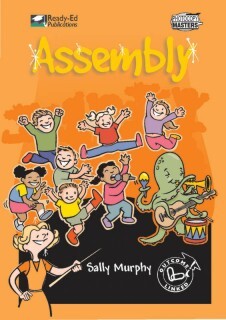 Assembly (published by Ready Ed Publications) is a collection of printable poems for use for performing, recitation or just having fun with, including poems suitable for middle primary. Each poem is printable, and is supported with a page of teaching notes. Available in hard copy or ebook format directly from the publisher .
Assembly (published by Ready Ed Publications) is a collection of printable poems for use for performing, recitation or just having fun with, including poems suitable for middle primary. Each poem is printable, and is supported with a page of teaching notes. Available in hard copy or ebook format directly from the publisher .Last, but certaily not least, I have three more books suitable for middle primary.
 Looking up (Published by Fremantle Press) is a novel about a boy who gets more than he imagined was possible for his tenth birthday. With topics of family and communication, and suitable for studies of narrative, as class read aloud and for private reading. You can read a Sample Chapter Here, Teacher’s Notes are available Here and some suggestions for Year Three teachers HERE.
Looking up (Published by Fremantle Press) is a novel about a boy who gets more than he imagined was possible for his tenth birthday. With topics of family and communication, and suitable for studies of narrative, as class read aloud and for private reading. You can read a Sample Chapter Here, Teacher’s Notes are available Here and some suggestions for Year Three teachers HERE.
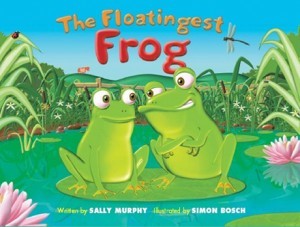 The Floatingest Frog
(illustrated by Simon Bosch, published by New Frontier). The story of two frogs who spot a cow and wonder if they can be bigger than it, it is based on an Aesop’s Fable, the Frog and the Ox, and also delas with competitiveness and sibling rivalry.
The Floatingest Frog
(illustrated by Simon Bosch, published by New Frontier). The story of two frogs who spot a cow and wonder if they can be bigger than it, it is based on an Aesop’s Fable, the Frog and the Ox, and also delas with competitiveness and sibling rivalry.What can it be used for: Because it is retold fable (you can see one version of the original fable here) there is the opportunity to explore fables and also link to science and the topic of frogs. You’ll find a collection of frog related videos used in a unit which followed on from reading The Floatingest Frog here .Although it is a little hard to find in stores, The Floatingest Frog is still held in many school and public libraries and available for sale directly from me, posted anywhere in Australia for $20. It is also perfectly accompanied by my nonficton title:
 Frogs: Awesome Amphibians (Published by Ready Ed) A handy classroom/library reference, or as private reading, it can be purchased online direct from the publisher. This excellent science unit of work could also be a useful resource.
Frogs: Awesome Amphibians (Published by Ready Ed) A handy classroom/library reference, or as private reading, it can be purchased online direct from the publisher. This excellent science unit of work could also be a useful resource.This is just a portion of what I have written suitable for this age group. There are also several reading series titles and novels including Doggy Duo.
And, if you’d like to see me in person, I am available to visit your school for author visits or to run professional learning. Feel free to contact me to find out more. You can also do the same if you’d like some advice on using my books in your classroom.
for author visits or to run professional learning. Feel free to contact me to find out more. You can also do the same if you’d like some advice on using my books in your classroom.
January 14, 2025
Books to Include in Your Junior Primary Classroom in 2025
Yesterday I shared some book suggestions for Early Childhood classrooms. Today I have some offerings for junior primary – years 1 and 2. If you are a teacher planning for the year ahead, these are books which I’ve written which you may find useful in your classroom, either for reading aloud, private reading for pleasure, or for English and other lessons.
Firstly, I have four picture books suitable for junior primary.
 Do Not Forget Australia (illustrated by Sonia Kretschmar and published by Walker Books). Telling a story of friendship between two boys and between two countries, through the events at the French village of Villers-Bretonneux in and after World War 1.
Do Not Forget Australia (illustrated by Sonia Kretschmar and published by Walker Books). Telling a story of friendship between two boys and between two countries, through the events at the French village of Villers-Bretonneux in and after World War 1.What it Can Be Used For: Because the battle of Villers-Bretonneux happened on ANZAC Day, this is an excellent resource leading up to ANZAC Day, but also Remembrance Day.
With an emphasis on similarites and differences between the two main characters, and links with Victoria, it can be used to address ACELT 1582 (Discuss characters and events in a range of literary texts and share personal responses to these texts, making connections with students’ own experiences) or, because of the amazing artwork, ACELA1469 (Identify visual representations of characters’ actions, reactions, speech and thought processes in narratives, and consider how these images add to or contradict or multiply the meaning of accompanying words).Do Not Forget Australia is included on the WA Premier’s Reading Challenge booklist.You will find publisher teaching notes here and some suggestions for using the book in junior primary here. Although aimed at the Year Five classroom, these suggestions, will also be helpful.
Do Not Forget Australia is still in print, and available in good bookstores or online.
 Meet Mary Mackillop (illustrated by Sonia Martinez, published by Random House). Part of the fabulous ‘Meet…’ series from random House, this is a fictionalised story of the life of Mary Mackillop, with a back of book timeline of her life.What it Can Be Used For: Because it features a famous Australian, there are obvious HASS uses, as well as use in Catholic schools, with Mary Mackillop being Australia’s first saint. But this is also the story of a strong woman, and highlights social justice and history, so is suitable for all classrooms. You will find publisher teacher notes here and suggestions for the year 4 classroom, which could be adapted for younger students here. Meet Mary MacKillop appears on the booklist for the South Australian Premier’s Reading Challenge and is still available in good bookstores or online.
Meet Mary Mackillop (illustrated by Sonia Martinez, published by Random House). Part of the fabulous ‘Meet…’ series from random House, this is a fictionalised story of the life of Mary Mackillop, with a back of book timeline of her life.What it Can Be Used For: Because it features a famous Australian, there are obvious HASS uses, as well as use in Catholic schools, with Mary Mackillop being Australia’s first saint. But this is also the story of a strong woman, and highlights social justice and history, so is suitable for all classrooms. You will find publisher teacher notes here and suggestions for the year 4 classroom, which could be adapted for younger students here. Meet Mary MacKillop appears on the booklist for the South Australian Premier’s Reading Challenge and is still available in good bookstores or online.
 The Floatingest Frog
(illustrated by Simon Bosch, published by New Frontier). The story of two frogs who spot a cow and wonder if they can be bigger than it, it is based on an Aesop’s Fable, the Frog and the Ox, and also delas with competitiveness and sibling rivalry.What can it be used for: Because it is retold fable (you can see one version of the original fable here) there is the opportunity to explore fables and address ACELY1665 (Discuss different texts on a similar topic, identifying similarities and differences between the texts) and also link to science and the topic of frogs. You’ll find a collection of frog related videos used in a unit which followed on from reading The Floatingest Frog here .Although it is a little hard to find in stores,
The Floatingest Frog
is still held in many school and public libraries and available for sale directly from me, posted anywhere in Australia for $20
The Floatingest Frog
(illustrated by Simon Bosch, published by New Frontier). The story of two frogs who spot a cow and wonder if they can be bigger than it, it is based on an Aesop’s Fable, the Frog and the Ox, and also delas with competitiveness and sibling rivalry.What can it be used for: Because it is retold fable (you can see one version of the original fable here) there is the opportunity to explore fables and address ACELY1665 (Discuss different texts on a similar topic, identifying similarities and differences between the texts) and also link to science and the topic of frogs. You’ll find a collection of frog related videos used in a unit which followed on from reading The Floatingest Frog here .Although it is a little hard to find in stores,
The Floatingest Frog
is still held in many school and public libraries and available for sale directly from me, posted anywhere in Australia for $20 Snowy’s Christmas
(illustrated by David Murphy, published by Random House). Although, in January, Christmas seems a very long way away, it will be here before you know it – and, besides, who says you have to wait until Christmas to read a Christmas story? Featuring a white kangaroo, this is an Australian Christmas story, and effectively an Australian version of the famous Rudolph story.What can it be used for: As always, reading for pleasure and, at the end of the year, particularly the pleasure and excitement of Christmas. Addressing literacy outcomes also listed above, but also a wonderful tie-in for Christmas-themed units of work, or units focussing on Australian animals., as well as on self acceptance and families. These teaching ideas, are linked to Year 2 learning outcomes.As with The Floatingest Frog, Snowy’s Christmas is a little hard to find in stores, but is still held in many school and public libraries and available for sale directly from me, posted anywhere in Australia for $18.
Snowy’s Christmas
(illustrated by David Murphy, published by Random House). Although, in January, Christmas seems a very long way away, it will be here before you know it – and, besides, who says you have to wait until Christmas to read a Christmas story? Featuring a white kangaroo, this is an Australian Christmas story, and effectively an Australian version of the famous Rudolph story.What can it be used for: As always, reading for pleasure and, at the end of the year, particularly the pleasure and excitement of Christmas. Addressing literacy outcomes also listed above, but also a wonderful tie-in for Christmas-themed units of work, or units focussing on Australian animals., as well as on self acceptance and families. These teaching ideas, are linked to Year 2 learning outcomes.As with The Floatingest Frog, Snowy’s Christmas is a little hard to find in stores, but is still held in many school and public libraries and available for sale directly from me, posted anywhere in Australia for $18.Secondly, some longer books for junior primary.
 Queen Narelle (illustrated by Simon O-Carrigan and published by Walker Books) is a verse novel told from the alternating viewpoints of Maddie and her cat, Narelle. The use of the cat’s voice makes it fun, but the issue Maddie is facing – about friendship challenges – is very real, and very important. What it Can be Used For: Verse novels are excellent as teacher read alouds, and, because of the combination of narrative and poetry can be used to address many parts of the curriculum including, in the case of Queen Narelle, ACELT1562 (Discuss characters and events in a range of literary texts and share personal responses to these texts, making connections with students’ own experiences). The exploration of friendship and bullying, as well as of family, makes it also an excellent text for HPE classes. You’ll find a simple teaching suggestion, pairing Queen Narelle with a stand alone poem, here.Queen Narelle is available in good bookstores or online, as well as in many school and local libraries.
Queen Narelle (illustrated by Simon O-Carrigan and published by Walker Books) is a verse novel told from the alternating viewpoints of Maddie and her cat, Narelle. The use of the cat’s voice makes it fun, but the issue Maddie is facing – about friendship challenges – is very real, and very important. What it Can be Used For: Verse novels are excellent as teacher read alouds, and, because of the combination of narrative and poetry can be used to address many parts of the curriculum including, in the case of Queen Narelle, ACELT1562 (Discuss characters and events in a range of literary texts and share personal responses to these texts, making connections with students’ own experiences). The exploration of friendship and bullying, as well as of family, makes it also an excellent text for HPE classes. You’ll find a simple teaching suggestion, pairing Queen Narelle with a stand alone poem, here.Queen Narelle is available in good bookstores or online, as well as in many school and local libraries.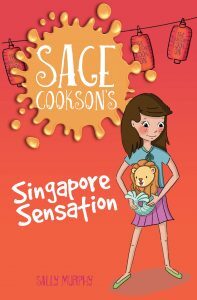 The Sage Cookson series (Published by New Frontier) Each of the eight books in this series stand alone, though as a series they work well read chronologically. Sage Cookson travels the world with her parents, who are TV chefs, but along the way she gets into lots of scrapes.What They Can be Used For: Series fiction is great for independent reading, particularly as it encourages readers to engage with multiple books. However, this series is also suitable for classroom read aloud, and has been used in studies of narrative structure and to teach the recipe text type, with each book featuring a back of book recipe. The series is included on the reading lists for the WA and NSW Premier’s Reading Challenges. Although harder to find in bookstores, this series can still be found in many libraries, or bought direct from the publisher or ordered from me.If you know anything about my writing, there’s a pretty good chance you know that I love poetry, and love to see it taught and enjoyed in the classroom. I have two books suitable for educators, both including poems by myself and others suitable for classroom use.
The Sage Cookson series (Published by New Frontier) Each of the eight books in this series stand alone, though as a series they work well read chronologically. Sage Cookson travels the world with her parents, who are TV chefs, but along the way she gets into lots of scrapes.What They Can be Used For: Series fiction is great for independent reading, particularly as it encourages readers to engage with multiple books. However, this series is also suitable for classroom read aloud, and has been used in studies of narrative structure and to teach the recipe text type, with each book featuring a back of book recipe. The series is included on the reading lists for the WA and NSW Premier’s Reading Challenges. Although harder to find in bookstores, this series can still be found in many libraries, or bought direct from the publisher or ordered from me.If you know anything about my writing, there’s a pretty good chance you know that I love poetry, and love to see it taught and enjoyed in the classroom. I have two books suitable for educators, both including poems by myself and others suitable for classroom use. Teaching Poetry for Pleasure and Purpose ( Published by PETAA) is, as the title suggests, designed to help you in teaching poetry in pleasurable ways, but also with the purpose of supporting the demands of the curriculum. There is a chapter for each primary school year, including Years 1 and 2, unpacking key terminology, suggesting activities both in reading and writing, and including poems and suggestions for further resources. Teaching Poetry for Pleasure and Purpose is available directly from PETAA in both hardcopy and digital formats. PETAA also offer an online professional learning module of the same name, where you can hear more from me on the teaching of poetry.
Teaching Poetry for Pleasure and Purpose ( Published by PETAA) is, as the title suggests, designed to help you in teaching poetry in pleasurable ways, but also with the purpose of supporting the demands of the curriculum. There is a chapter for each primary school year, including Years 1 and 2, unpacking key terminology, suggesting activities both in reading and writing, and including poems and suggestions for further resources. Teaching Poetry for Pleasure and Purpose is available directly from PETAA in both hardcopy and digital formats. PETAA also offer an online professional learning module of the same name, where you can hear more from me on the teaching of poetry. Assembly (published by Ready Ed Publications) is a collection of printable poems for use for performing, recitation or just having fun with, including poems suitable for junior primary. Each poem is printable, and is supported with a page of teaching notes. Available in hard copy or ebook format directly from the publisher .
Assembly (published by Ready Ed Publications) is a collection of printable poems for use for performing, recitation or just having fun with, including poems suitable for junior primary. Each poem is printable, and is supported with a page of teaching notes. Available in hard copy or ebook format directly from the publisher .Last, but by no means least, I am the co-editor of a wonderful poetry anthology.
 Right Way Down (edited by Rebecca M. Newman and myself) and published by Fremantle Press) is aimed chiefly at middle and upper primary, but you will find poems in there that will also appeal to junior primary students. You will find teaching notes here and printable poetry activities here. Right Way Down is still available in good stores or online in hard copy or ebook format.
Right Way Down (edited by Rebecca M. Newman and myself) and published by Fremantle Press) is aimed chiefly at middle and upper primary, but you will find poems in there that will also appeal to junior primary students. You will find teaching notes here and printable poetry activities here. Right Way Down is still available in good stores or online in hard copy or ebook format.
This is just a portion of what I have written suitable for this age group. There are also other picture books, which unfortunately are no longer in print, but may be in your school library (including Fly in Fly Out Dad and Pemberthy Bear) as well as several reading series titles and novels including Doggy Duo and Roses are Blue.
And, if you’d like to see me in person, I am available to visit your school for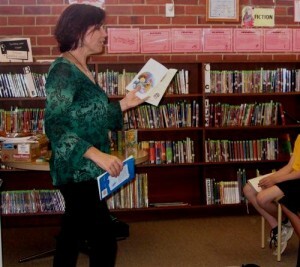 author visits or to run professional learning. Feel free to contact me to find out more. You can also do the same if you’d like some advice on using my books in your classroom.
author visits or to run professional learning. Feel free to contact me to find out more. You can also do the same if you’d like some advice on using my books in your classroom.




